A high-quality wiring connection is the most important requirement for home safety. An unreliable contact can lead to a short circuit and fire, therefore it is important to be able to qualitatively and reliably connect the two conductors in the junction box. There are different methods of creating contact, and they all have their own characteristics.
The need for a reliable connection
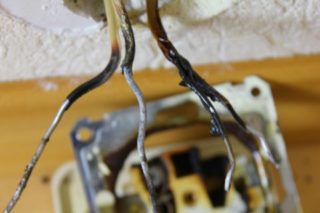
First of all, you need to figure out why it is so important to pay attention to the reliability of the connection of the conductors. Even PUE give recommendations on choosing a connection method and strictly prohibit twisting of wires.
Consequences of incorrectly connected conductors:
- Fire. Poor contact has a large transition resistance. This leads to heating, which can lead to fire in the future.
- Damaged wiring. Due to the high resistance, the conductor heats up faster. As a result, the insulation can melt and the contact itself can be destroyed. Breaking the insulation layer can result in electric shock.
- Short circuit. It also depends on the magnitude of the contact resistance.
Large transient resistance leads to negative consequences. Therefore, it is important to reduce it, for which permitted methods of connecting stranded conductors are used.
Connection methods
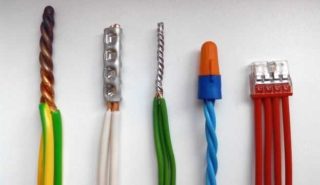
Of the permitted methods, the PUE allows you to create a contact in the following ways:
- clamps;
- terminals;
- crimping;
- soldering, welding.
Twisting is prohibited. This is because the contact will be exposed to temperature. As the temperature rises, the material expands; on cooling, on the contrary, it narrows. Since the contact is not secured by anything, it will quickly fail and collapse. Twisting can only be used in conjunction with other joining methods such as welding or brazing.
Compression method
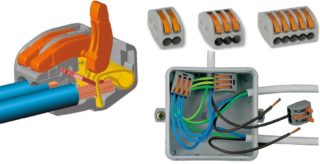
This method includes screw and bolt connections as well as contact using Wago clamps. Such mechanisms make it possible to connect solid and stranded copper wire. At the moment, this method is the most common and convenient. The advantages include low cost, reliability, simplicity of the process and no need to purchase additional equipment.
It is better to connect wires with a cross section of up to 25 sq. Mm in this way. Conductors with a large cross-section require a different connection or it will be necessary to take into account the nuances when contacting using the compression method.
The screw connection is used for cables with small cross-sections. Its essence lies in installing two conductors in a brass tube and clamping each segment with its own screw. When connecting single-core and multi-core cables, there is a risk of damage to the fine wire. For this reason, it is recommended to protect them with a special tip. There are special terminals with a clamping pad for which the use of lugs is not required. They provide high-quality clamping without damaging the wire over the entire cross-section of the brass tube.
Wago terminals are a variation of the clamping method. They are reliable, but experts are arguing about the durability of such products. Advantages - speed of work, quality of contact, simplicity.
Pressing method
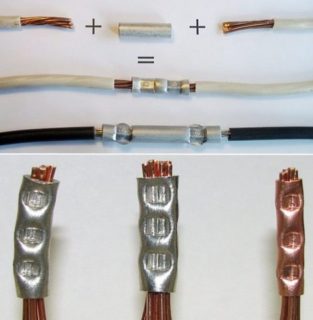
Crimping of wires is carried out using a special tool - pliers. It can be manual or hydraulic.Hand-held pliers are suitable for conductors with small cross-sections.
You will also need special sleeves made of copper, aluminum or brass. They are selected for the appropriate material of the cable cores. If you need to connect several stranded wires in front of the terminal block, lugs are used.
Pressing is used for all types of cables - stranded, single-core, their combinations. It is only important to choose the correct liner type and pressure.
Welding method
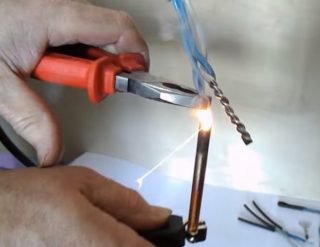
Welding wires is the most reliable and durable connection method. Its disadvantage lies only in the difficulty of doing it yourself, since a professional welding machine is required for work. There are also requirements for the experience of the master - in the absence of the necessary skills, you should choose another method of connection or entrust the work to a professional.
With the help of a welding machine, the ends of the cores are melted. When they solidify, a single whole is formed between the two segments and a high-quality contact is ensured. With this method, you can connect an unlimited number of conductors at one point. But you need to understand that when a single-core and multi-core cable contacts, difficulties will arise. The foreman will have to complete a few additional steps before welding. Connecting a four-core wire to a single-core wire:
- Melting the termination of a stranded wire.
- The connection of the molten conductor with a single strand.
If the welding technique is violated, individual cores may burn out and contact will not be provided for all wires.
Soldering
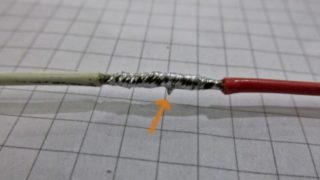
To solder two pieces of cable, you will also need additional tools - a soldering iron, rosin, solder, soldered fat. The master must be able to solder, otherwise it will not work to provide a reliable contact.
How to twist a stranded wire together with a solid one:
- Stripping of insulation.
- Surface treatment of both conductors with rosin.
- Winding a multi-core cable onto a single-core cable.
- Bending of a single-core cable, crimping with pliers.
- Treatment of the place with soldering fat and solder.
There is also a connection option when the treatment with fat and rosin is performed separately for each part of the wire. Then the conductors are connected in parallel and the contact is processed with solder.
It is easier to connect single conductors. To do this, it is enough to strip them of insulation and treat them with rosin. Then the cables need to be soldered. If a tinned solid conductor is used for the connection, rosin treatment is not required.
Stranded wires are also stripped of insulation. This can be more difficult as each core has its own insulating layer. Further, the conductors are connected with a pigtail or twisted and processed with solder.
Connection of flexible and rigid wires
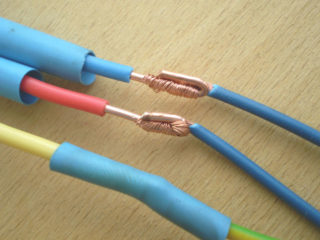
Conductors of the same type are usually connected. But sometimes a connection of a flexible and a rigid wire is required, which is performed with observance of some nuances.
First, cut the cable so that the end is tapered. The rigid wire must be melted and a loop made at its end. A thin wire is passed through the loop made and wrapped around the rigid cable. The resulting connection must be processed with solder and securely insulated. This method is suitable for aluminum conductors.









Not single-core and stranded, in this case, but single-wire and multi-wire.
The author has a mess in his head, he does not understand the definitions: a single-core cable and a multi-core cable are significantly different things. If the wire consists of several wires of small cross-section, then this is a stranded wire. There is no definition of a hard wire - there is a single conductor, there is a multi-wire conductor. In electrical installations up to 1000V, soldering is not allowed.With an increase in the contact resistance, the current in the circuit decreases. By increasing the resistance to infinity, we reduce the current to zero - Ohm's Law. Overheating of conductors depends on the subsequent destruction of the insulation only on the temperature regime of the environment and the mismatch between the load and the cross-section of the conductors. A short circuit does not depend on a large contact resistance, but on a dead circuit of conductors that are not in the same phase.
Written for people and not for nerds (popularly stranded and single-core wire)
And in my experience, a simple twist (twisted with pasatizh) is better than any vagi